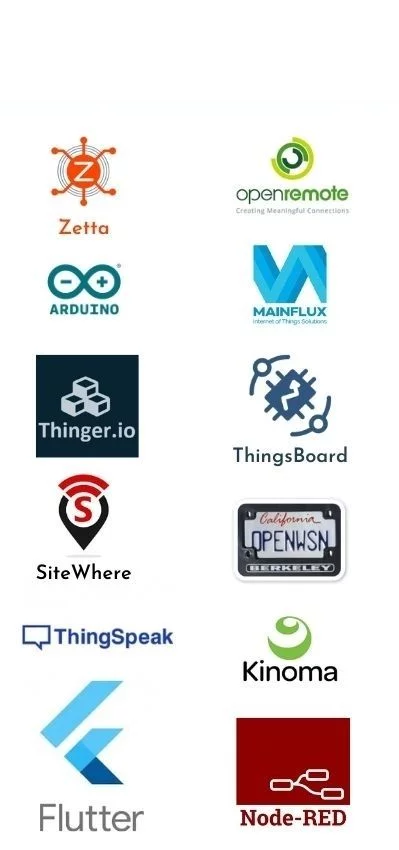Open-source IoT Platforms offer state-of-the-art capabilities by amalgamating IoT devices with Cloud Computing. IoT Platforms are also known as Cloud Service IoT Platforms. Further, with the increase in technological phenomena, billions of devices utilize the Internet. Moreover, the devices function as sources that efficiently collects and processes data for various applications.
That is to say, Open-source IoT Platforms improve the analysis of operational data. Therefore, the solutions enhance performance, maintain quality, and ensure business continuity. Open-SourceIoT platforms also offer capabilities to manage connectivity for data procurement and assessment. Therefore, it increases uniformity, scalability, and agility in business operations.
According to IoT Analytics, “The number of IoT platforms might have stopped growing, but the size of the market has still increased substantially. In 2020, $5 billion were spent on IoT platforms. The market is expected to grow to $28 billion in 2026. That constitutes a 33% compound annual growth rate (CAGR) for 2020 to 2026. ”
Hence, this article will discuss the various Open-SourceIoT Platforms businesses need to engage with.
Understanding Open Source IoT Platforms for various businesses
What are IoT Platforms?
IoT Platforms are an important component in the IoT environment that increase horizons. Moreover, they bridge the gap between components to transfer, store and maintain data. Further, it builds hardware and software solutions using basic Internet protocols while connecting device sensors and data resources.
Gartner states that “An IoT platform is an on-premises software suite or a cloud service (IoT platform as a service [PaaS]) that monitors and may manage and control various types of endpoints, often via applications business units deployed on the platform. The IoT platform usually provides (or provisions) Web-scale infrastructure capabilities to support basic and advanced IoT solutions and digital business operations.”
Moreover, Open-SourceIoT platforms incorporate decentralization models to collect, analyze, visualize, and manage devices. Hence, the platforms help with decision-making processes by deriving actionable insights.
How do IoT platforms work?
Firstly, an IoT infrastructure consists of a few essential components: hardware, software, user interface, and network. Further, an IoT platform integrates the components to build a cohesive, compliant, and comprehensible infrastructure.
- The platforms collect and transfer data through connected devices using secure cloud gateways. Moreover, it enables devices to convert data into various formats and transfer data using a plethora of connectivity services.
- Further, post the data transmission to the cloud storage and repository processes, analyzes, and segregate the data. It also runs the data through various metrics to help businesses procure actionable insights.
- Moreover, IoT platforms arbitrate between devices and applications to gather insights. Hence, it empowers machines and solutions for better performances, leading to better decision-making processes.
In other words, IoT platforms accelerate the deployment of IoT functions to build a robust ecosystem. Therefore, the platforms integrate and connect billions of devices globally using the cloud as a central system.
Types of IoT Platforms
Here are the five pivotal types of IoT Platforms:
-
IoT Connectivity Management Platforms:
IoT Connectivity Management Platforms refer to the central integrating components in IoT ecosystems. The platforms offer users software solutions, hardware accessibility, and data acquisition to connect devices to a network. It also depends on device configurations and IoT setup to execute various functions.
-
Iot Device Manegement Platforms:
IoT Device Management Platforms offer solutions for mundane activities in the IoT ecosystem. Moreover, it ensures connectivity and security to update users regarding the conditions and positions of various devices. Further, it updates, notifies, reports, and reinforces changes within the devices. As a result, device management platforms successfully run routine tasks and processes.
-
IoT Cloud Platforms:
IoT Cloud Platforms offer users ecosystems that generate compatibility within IoT devices. Moreover, it provides centralization to various backend processes to analyze data. It also offers scalable solutions to help develop cloud platforms from scratch.
-
IoT Application Enablement Platforms:
IoT Application Enablement Platforms are a standard and versatile approach to fulfilling the basic requirements. Moreover, it provides devices, solutions, advancements, and executions of IoT systems. Further, the solutions are all-inclusive systems that manage, network, configure, and engine components.
-
IoT Advanced Analytics Platforms:
IoT Advances Analytics Platforms offer expert solutions for data-centric IoT infrastructures. Further, it provides a mature and futuristic solution for IoT systems. It also implements machine learning, artificial intelligence, and statistical models to analyze large data sets. Moreover, it interprets and analyzes data to perform tasks and improve processes.
Key Features of Open Source IoT Platforms
-
Transparency:
Firstly, Open-Source IoT Platforms provide extensive and continual capabilities per user requirements. As a result, developers build solutions, share insights, and make decisions more efficiently.
-
Collaboration:
Further, the Open-Source IoT platforms offer opportunities for various developers and businesses for free collaborations and integrations. It also provides the capabilities to customize and develop solutions while increasing horizons. Moreover, it creates opportunities for individual developers to build their solutions as per their requirements.
-
Deployment:
Open-Source IoT Platforms help create prototypes to develop continual approaches for solutions. Moreover, it streamlines processes to strategize optimal solutions in the Iot infrastructure. Therefore, deployment becomes easier for the solutions owing to the freedom of experimentation and development in perceptions.
Here is a list of 12 Top Open-Source IoT Platforms for businesses
Zetta is the first API-enabled Open-Source IoT Platform built using NodeJS, REST, and flow-centric reactive programming development. Although the solution lacks dynamic data visualization, it offers “reactive programming”. That is to say; it is a complete solution that generates HTTP APIs for devices by combining REST APIs, WebSockets, and data-centric solutions for real-time applications.
Arduino is one of the best Open-Source IoT Platforms that include hardware and software. Moreover, its software includes IDE that composes codes in the Arduino language.. Further, it provides a perceptive and robust solution to monitor and manage real-world requirements. It is also a simple and easy IoT Platform that runs tasks and maintains interactions between components.
Thinger.io is a free and Open-Source IoT Platform is a scalable cloud solution. Further, it uses Docker containerization to deploy functions and applications. The creators of the platform state that it is “easy to use, and easy to understand. No more complex code for doing simple things.” Hence, it enables users to amalgamate, manage, and maintain a plethora of IoT devices with its easy and accessible capabilities.
-
SiteWhere
SiteWhere includes repositories, processes, and integrations to develop scalable IoT applications. Moreover, it incorporates MongoDB, HBase, Hortonworks, Clouder, Apache Solr, and Twilio with various cloud computing platforms. It also enables cloud platforms like AWS, Azure, GCP, etc, along with Kubernetes clusters.
ThingSpeak is a newer IoT Platform that integrates with MATLAB to help analyze and visualize data. Moreover, it leverages MATLAB’s data analysis capabilities and numberless sensors. It also uses channels to store data from various sources. Further, it helps generate channels to analyze data and offer flexibility to users. Above all, the ThingSpeak prototype encourages users to develop their solutions mitigating the hassle of server configurations or software setups.
OpenRemote is a fully compact Open-Source IoT Platform that generates applications. Moreover, it is a commercial solution that enables various Internet of Things applications. That is to say; it develops management solutions for energy, crowd, and genric assets for a business. Further, it uses protocol agents like HTTP REST or MQTT to integrate various devices, gateways, and data solutions in the IoT infrastructure.
MainFlux refers to the patent-free and Open-Source IoT platform that incorporates Edge Computing in its solutions. Moreover, the platform provides complete transparency solutions for data management, core analytics, and scheduling. It also enables users to manage and monitor their assets along with community testing, support, and fixing bugs. Further, the platform was initially developed as a suite of containerized microservices coordinated by Kubernetes.
ThingsBoard is an Open-Source IoT platform that collects and stores data assessments using scalable and accurate approaches. Moreover, it gathers data from IoT devices to analyze and process them to procure actionable insights. Further, its dashboard and custom widgets help visualize and share the insights for decision-making. It also uses standard IoT protocols to integrate devices to implement on-premises and cloud deployments.
OpenWSN is the directory of IoT software and hardware solutions developed at the University of California Berkely. Further, it intends to offer usres a full standard-centric open-source IoT stack. It also enables the implementation of academic and business requirements to become a pervasive platform.
Marvell Semiconductor introduces Kinoma, a hardware modeling IoT platform to incorporate various open-source applications. That is to say, Kinoma Create is a DIY development tool that models electronic devices. Further, Kinoma Studio is a building infrastructure that executes Set up and Kinoma Platform Runtime. On the other hand, Kinoma Connect is a free platform that integrates solutions for various devices.
Flutter is a highly programmable system for electronic, design, and engineering projects. Moreover, it offers users an extensive range of solutions that uses an Arduino-centric board. It also includes wireless sensors that transmit information for more than a mile. Above all, it is a router-free open-source IoT platform that creates quick interactions.
Node-RED is one of the Open-Source IoT platforms that offer visualization of data, devices, and developments. Moreover, it was built on Node.js and referred to itself as “a visual means for wiring the Internet of Things.” It also enables developers to integrate devices, solutions, and APIs with browser-centric software. Above all, it can execute a function on Raspberry Pi and enable access for around 60,000 models as per user requirements.
Conclusion:
In conclusion, Open-Source IoT platforms provide businesses with extensive connectivity opportunities that ensure growth and productivity. Moreover, the platforms exhibit potential for democratizing and developing global solutions.
You May Also Like to Read:
IoT and Quantum Computing: A Futuristic Convergence!
IoT and Augmented Reality Examples: Promising a Better Connection
IoT Solutions for the Automotive Industry
Here are the Top Applications of AIoT across various industries


